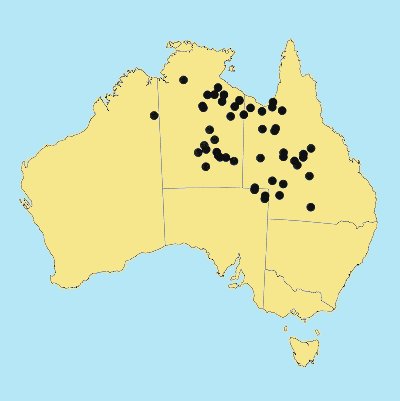Eragrostis confertiflora J. M. Black. Trans.&
Proc. Roy. Soc. South Australia
55: 136 (1931).
Classification. (GPWG 2001) : Subfamily Chloridoideae.
Cynodonteae.
Basionym and/or
Replacement Name: Eragrostis
interrupta var. densiflora J.M. Black, Trans. & Proc. Roy.
Soc. South Australia
48: 253 (1924).
Type of Basionym or
Protologue Information: Toorawatchy Waterhole, between Cordillo Downs and
Innamincka, J.B. Cleland s.n..
Key references
(books and floras): [1981] M.Lazarides in J.Jessop (ed)., Flora of
Central Australia (459), [2002] D.Sharp & B.K.Simon, AusGrass,
Grasses of Australia, [2006] J.Jessop, G.R.M.Dashorst, F.M.James, Grasses
of South Australia (367).
Illustrations:
[2006] J.Jessop, G.R.M.Dashorst, F.M.James, Grasses of South Australia (367, fig. 295).
Habit. Annual
or ephemeral. Culms erect or decumbent, 16–40 cm tall, 1–2 -noded. Ligule a
fringed membrane or a fringe of hairs, a ciliolate membrane or a ciliate
membrane, 0.3–0.5 mm long. Leaf-blades straight, flat, 6–12 cm long, 1–3.3 mm
wide.
Inflorescence.
Inflorescence compound, a panicle. Panicle linear or lanceolate, 5–25 cm long,
0.5–1 cm wide.
Spikelets.
Spikelets sessile or pedicelled. Fertile spikelets many flowered, with at least
2 fertile florets (5–10), comprising 5–10 fertile floret(s), with diminished
florets at the apex, linear or oblong, laterally compressed, 2–5 mm long.
Glumes. Glumes
similar. Lower glume lanceolate, membranous, keeled, 1-keeled, 1 -nerved. Upper
glume lanceolate, 0.75 mm long, membranous, keeled, 1-keeled, 1 -nerved.
Florets.
Fertile lemma 0.8–1.1 mm long, keeled, 3 -nerved. Lemma apex muticous.
Lodicules present. Anthers 2.
Continental
Distribution: Australasia.
Australian
Distribution: Western Australia, Northern Territory, South Australia,
Queensland.
Western Australia: Hall. Northern Territory: Darwin & Gulf, Barkly
Tableland, Central Australia North, Central Australia
South. South Australia: Lake Eyre. Queensland:
Burke, South Kennedy, Gregory North, Gregory South, Mitchell, Warrego.
Notes.
Distinguishing characters include spiciform compact panicles long relative to
plant; membranous ligule; shiny turgid caryopsis; two stamens; 3-lobed palea with
almost smooth keels shorter than body and flaps; membranous-hyaline glumes,
lemmas and paleas; fragile rachilla cupular at apex of internodes. There are
many similarities with E. tenellula, its chief difference being its
spiciform (not open, decompound) panicle.
Endemic;
occurs on Gordon Downs Stn in W.A. just near the border, then throughout
central N.T. from about Katherine E into SW Qld and the far NE corner of S.A.
Black cracking clay grassland plains; seasonally wet swamps, and creek bed and
banks; red-brown loamy swales of sandhills; lateritic soils.; flowers
Apr.-Sept.; fruits Apr.-Sept.



